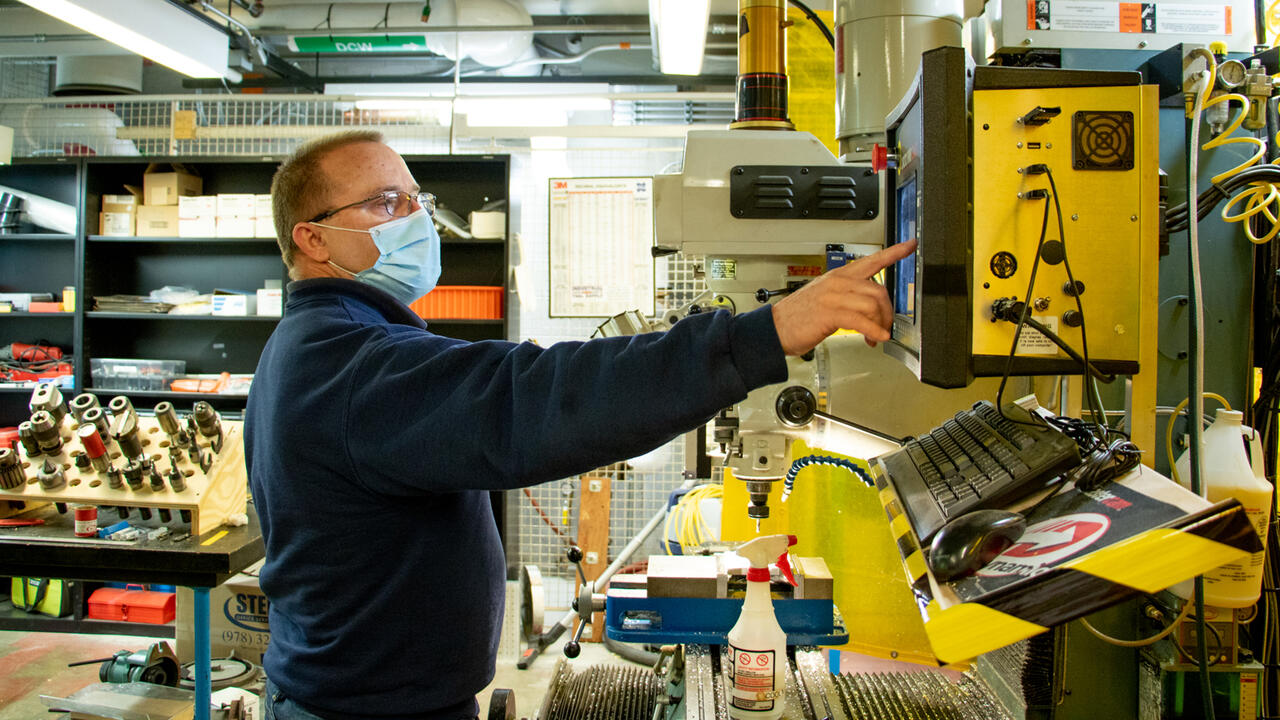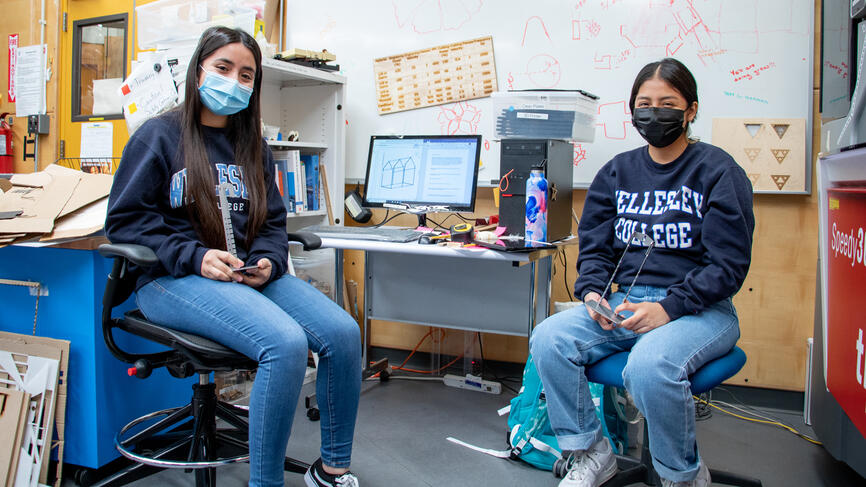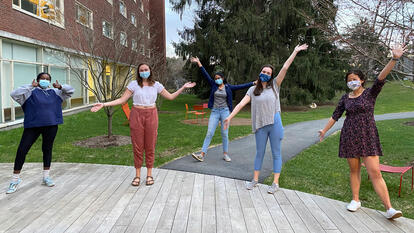
A Chance Encounter in a Convenience Store Led Wellesley Machinist Larry Knowles to a Lifelong Career
Almost everywhere Larry Knowles looks, he sees a machinist’s touch.
“Anywhere you are, most things you see—cars, toys, electronics, buildings—were built, in part, by a machinist somewhere,” said Knowles, Wellesley College’s machinist. “And almost anywhere you go in the United States, there’s probably a dozen machine shops within a five-mile range in populated areas of wherever you stand.”
Knowles conceptualizes and designs precision metal parts, instruments, and tools for a variety of College community projects and needs. His work connects him with almost every part of campus, including students, faculty across many of the College’s academic departments, and the facilities management team.
His journey as a machinist began one night in the early 1980s, when he was working at a Cumberland Farms convenience store. A customer came in and, apparently impressed with how Knowles was handling a particularly busy moment, slid his business card across the counter at checkout.
“He said, ‘If you ever need a job, you come see me,’” Knowles said. “I think it was because of the manner in which I was working. I was hustling. It may just have been by happenstance. The guy liked the way I worked.”
That encounter changed the course of his life. The customer owned a shop specializing in machining and precision sheet metals, including the kind of metals that housed computers at the time. Knowles took him up on his offer and soon after began apprenticing with him in his shop.
It’s great, watching [the students’] progression, and opening the door for them, in the outside world. They realize, ‘Wow, I can use these skills, too, perhaps in a whole lot of places.’
Larry Knowles
“That started me off just as a journeyman. With the help of both a night class in machining and my best friend, who is a very talented machinist himself, I worked my way up to manager, and eventually ended up working at Harvard University,” Knowles said. He worked at the Center for Astrophysics, which is jointly run by Harvard and the Smithsonian, for nearly two decades. When the machine shop ownership transferred from Harvard to the Smithsonian, he worked there for three more years before arriving at Wellesley.
Over the course of his career, he’s built bicycle parts; designed, built, and sold fly-fishing reels; and machined parts for both land and space telescopes, MRI machines, mammography instruments, and much more. He’s even worked on parts for the Chandra Telescope and the Parker Solar Probe, one of his favorite projects. It was NASA’s first mission to “touch” the sun, by sending a satellite to travel directly through the sun’s atmosphere, ultimately to a distance 4 million miles above its surface. “I have a part in that satellite that is looking directly at the sun and facing temperatures of 2,500 degrees Fahrenheit,” Knowles said.
Knowles had been interested in mechanics as a child. His father, a police officer for the town of Burlington, Mass., taught him and his 10 siblings how to fix things around the house. He kept a basement shop in their home.
“For me, that’s where my mechanical abilities started,” Knowles said. “My dad taught all of us how to work on cars, small engines, and other mechanical things in the basement shop. He instilled that kind of work ethic, and working with your hands at the mechanical end of things, in us, as much as he could while trying to raise 11 kids.”
At Wellesley, Knowles works with faculty and students to build and repair all manner of objects. He has made equipment for the inside of the College’s MRI machine and frequently works with the chemistry department on back-end system components, including a faraday collector unit and substrate sample and photodiode holders, which had to work in an ultra-high vacuum system. He also teaches engineering and physics students to use hand tools and machinery as well as the engineering laser and 3D printers.
Increasingly, he designs and builds parts that do not yet exist. “Earlier in my career, I wasn’t doing much design work,” Knowles said. “I was mostly fabricating. Wellesley really opened the door [for me] to be more involved in design, and coming up with ideas or coming up with solutions for others.”
In 2019, Knowles and John DeBolt, an advanced instrumentation specialist at the College, received Wellesley’s annual Champions of Innovation and Collaboration award for their work moving sensitive scientific equipment and specimens from the old Science Center into the new one.
“Time and time again, they have teamed up to figure out ways to protect and transport some of our most delicate specimens and instruments across campus, whether transferring a massive fossilized tree stump safely to its new home in Global Flora, or developing and successfully implementing a plan to transport our NMR spectrometer—one of our most expensive and sensitive instruments,” President Paula Johnson said in announcing the honor. “They pride themselves on figuring out ways to keep us from needing to bring in outside specialists or service technicians, saving the College tens of thousands of dollars in the process.”

Knowles also leads a team of student interns, who tackle projects for various campus departments. This spring, they finished a nearly year-long project for Global Flora’s botanic gardens. Their job was to create plant hangers that would hold pots of multiple sizes and hang from a wall with only one screw.
The team couldn’t find an effective design, so they made their own.
“Creating the plant hangers for the botanic gardens was challenging,” said Yeni Rubio ’23, who is majoring in economics and psychology. “There were many points when our team would be confused or not know what to do next. Not only were we customizing the design for the plant hangers, but we also had to learn how to use Onshape, a design software system, to sketch our design and see what it would look like.”
The team built multiple models for the hangers, using software as well as cardboard, wood, and metal. Once they had settled on a final prototype, they sent it to an outside shop that specializes in laser cutting of stainless steel to build the final 300 units of hangers.
“There were times when the part didn’t work the way we wanted, and it was frustrating to see multiple prototypes fail as we worked toward a final design,” said Ingrid Betancourt ’23, a computer science major. Betancourt had heard about some of the machines in the shop from Rubio, and she was curious about how they functioned as well as eager to learn new digital design programs. “I decided to apply to work there to explore a different form of science than I am used to,” Betancourt said. “I’ve really enjoyed exploring this side of computer-aided design, and it’s become something fun that I want to learn as much about as I can.”
Knowles invites anyone who is interested to visit the shop and learn about the work he does. “A lot of people have never built anything in their life,” Knowles said. “It’s funny, you get a crowd of students who come in, and some of them, you get the hand across the face, a ho-hum kind of yawning, and then they build something. Hopefully something they came up with, and then they want to spend more and more time building. Because most fall in love with it.”
Knowles believes the satisfaction that arises from building something leads to that shift.
“It’s the accomplishment. That ability to do something that they’ve never done before,” he said. “It’s great, watching that progression, and opening the door for them, in the outside world. They realize, ‘Wow, I can use these skills, too, perhaps in a whole lot of places.’”



